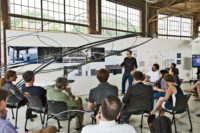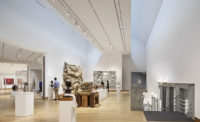Italian architects FATmaison design a private chapel in Gabon using an unusual mix of materials
| Photo courtesy FATmaison |
| The architects designed a private memorial chapel in Libreville, Gabon, using a mix of modern and traditional materials and forms. The apse, enclosed in Cor-Ten steel and incised with a cross, is finished inside with Carrara marble and pine. |
Several years ago, Italian architects Diego Quadrelli and Silvia Terrenghi of FATmaison received an unusual commission after going on a holiday to Gabon, the oil-rich West African country with a population of 1.6 million. Acquaintances introduced the two to Dr. Marcel Eloi Chambrier-Rahandi, a former prime minister of this country (which won its independence from the French in 1960). Later, when his wife, Roselyne Ossengue Chambrier, died, he decided to build a chapel and tomb for her on wooded property near their home in Libreville, Gabon's capital. The client was enamored of Italian architecture and its traditional use of Carrara marble. The architects, whose office is in Monza, Italy, near Milan, had a modern design in mind and favored Cor-Ten steel cladding with channel glass. So they came up with a scheme that combines both traditional and modern materials and typologies. Known as the Revival Sunset Chapel, the 1,780-square-foot structure, whose symmetrical plan resembles a priest's vestment, has a curved Cor-Ten apse embracing the altar on the west, where Carrara marble dominates the interior. Black marble covers the floor of the dark rectangular tomb on the east, also enclosed in Cor-Ten. In the middle, the chapel's steel frame rises to a series of narrow gables crossing the nave. While the serrated roofline vaguely recalls an early modern factory, Quadrelli notes this motif recurs in Gabon's decorative objects.
The sanctuary, which seats 200, is not air-conditioned. Rather, the architects hung channel glass from the structural frame so that breezes flow through generous gaps. The louvers in turn pivot to increase ventilation while still sheltering those inside from Libreville's frequent rains.
Owing to the complexity of constructing the chapel, the architect and client decided to have the $350,000 building prefabricated in Genoa by the contractor, then taken apart and shipped to Libreville to be assembled again on site. After 45 days, the lean kit of parts arrived in two 40-foot-long containers. Local workers had prepared the land and poured the foundations, and a team of Italian workers were able to put the structure together in less than a month.
The Catholic chapel opened March 1, 2013, the first anniversary of the death of Madame Chambrier. “It was so important to have it ready on time,” says Quadrelli. Certain aspects of the design heighten the experience of the memorial. For example, the architects carved a cross out of the apse wall so that the rays of the setting sun illuminate the marble floor with the shape of a crucifix and send light to the tomb, which most of the time is bathed in a crepuscular gloom. It is “a symbol of rebirth after death,” says Quadrelli.
The name of the firm, FATmaison, has its own significance. Formed from the acronym of the firm's motto (in English), “Feel Architecture of Tomorrow,” and fused with the French noun for “house,” the architects wished to capture their globally oriented and free-thinking spirit: “We are young and want to work all over the world,” Quadrelli says of the largely residential practice formed in 2008. As seen in the design of the chapel, the two bring all the multivalent sensibility of their name to their mission.






















